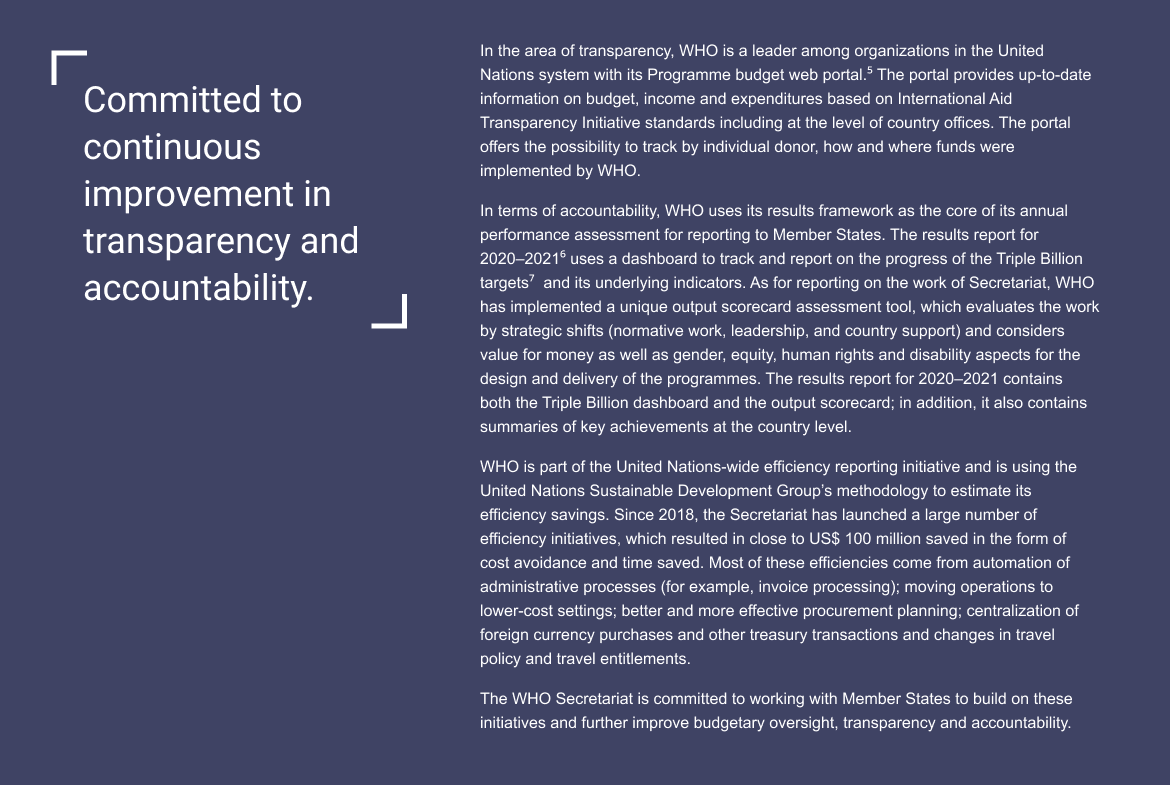
Chapter 3
A new estimate for the return on investing in WHO
A new estimate for the return on investing in WHO
WHO’s first investment case, published in 20181 estimated the rate of return for the net efforts of all actors in relation to each of the Triple Billion targets. This second investment case builds on that work, taking an attribution approach to estimating the return to investing in WHO itself.
This analysis of the return on investment in WHO quantifies the public value created by WHO and, using a likely estimate of the cost of funding WHO over the coming decade, calculates the rate of return on that investment. The public value created by WHO is achieved through the often unique set of tools and skills that WHO uses as it develops and implements global public goods including global plans, guidelines and other supporting action to achieve impact towards its Triple Billion targets.
These tools include leadership, partnership and convening activities, developing a consistent knowledge base, establishing standards, and developing and supporting the use of normative guidelines. In the more than 150 countries, areas and territories where WHO has a country office, WHO cooperates with national authorities in policy dialogue to develop health systems to meet future needs, and provides strategic support to build high- performing systems and technical assistance to build national institutions.
The risks to health are exacerbated in fragile, conflict-affected and vulnerable countries and, where WHO has a presence in such countries, the Organization has had to deliver services to fill critical gaps in emergencies.
Making this estimation faces several challenges: there are many areas of WHO’s work where the value of the health benefits created has not been calculated and there are uncertainties in any calculation of the benefits generated by WHO that accrue from the totality of the Organization’s efforts and accumulate over a long period. Also, the public value created by WHO is itself dynamic as both health needs and benefits vary across regions and over time.
The approach taken in this investment case has therefore been a conservative one – to make an estimate of the return on investment where there are good data to draw on and where methodologically precise and consistent calculations can be made. It therefore represents a major underestimation of the total return on investment in WHO.
The central cost case for the investment analysis starts from WHO’s latest approved Programme budget for the 2022–2023 biennium, which already incorporates some allowance for strengthening WHO’s activities. This budget is then increased by 5% per year in real terms through to 2031.2 The total level of funding available to WHO over the period 2021–2030 is then calculated as the net present value of this funding stream at a discount rate of 3% per annum.3 On this basis, under this model, the net present value of future funding over the decade is US$ 33 billion.
To estimate the value of the benefits created by this investment in WHO, we start by estimating the future economic benefits of improving health outcomes at the country level by scaling up a large set of interventions which contribute to the achievement of the Triple Billion targets. Attribution of these benefits to WHO was calculated by estimating the contribution of national governments, WHO and other global heath actors in achieving the outcomes of interest.

The dimensions of attribution vary across programme area, including roles such as strengthening leadership and governance, strengthening country capacity, implementation of strategic responses, advocacy for action, supporting research and development, and supporting monitoring and evaluation systems. Attribution rates vary from 5% for the role of WHO in implementing immunization programmes to 16% for the role of WHO in pandemic preparedness.4
With an estimate of the public value created by WHO’s action across a range of health areas, the benefit cost ratio of investment in WHO can be calculated as the ratio of the net present value of the attributable benefits to total expenditure by WHO over the decade. The benefits attributable to WHO from programmes implemented during the period 2022–2031 will produce an estimated attributable benefit of between US$ 1.155 trillion and US$ 1.46 trillion. The estimates are expressed in net present value terms (at a discount rate of 3%) for both a lower and a higher rate of attribution to WHO.


The quantifiable return on investment in WHO is very substantial. The cost of WHO in net present value terms over the coming 10-year period, 2022–2031, is US$ 33 billion and the public value created as a result of this investment in the most conservative estimation possible is likely to be between US$ 1.155 trillion and US$ 1.46 trillion. The resulting return on investment is US$ 35 for every US$ 1 invested in WHO.


- A healthier humanity: the WHO investment case for 2019–2023. Geneva: World Health Organization; 2018 (WHO/DGO/CRM/18.2; https://apps.who.int/iris/handle/10665/274710).
- Please note that the figure of 10% was chosen as a modelling figure based on past performance over a number of bienniums. Any actual budgetary increase requested would be the outcome of the full budgetary development process for the biennium concerned and would need to be approved by the World Health Assembly.
- Bertram MY, Lauer JA, Stenberg K, Tan-Torres Edejer T. Methods for the economic evaluation of health care interventions for priority setting in the health system: an update from WHO CHOICE. Int J Health Policy Manag. 2021;10(11):673–7. https://dx.doi.org/10.34172/ijhpm.2020.244.
- WHO investment case 2.0: technical report. Melbourne: Victoria Institute for Strategic Economic Studies; 2022 ( https://www.vu.edu.au/sites/default/files/who-investment-case-technical-report-march-2022.pdf).
- WHO Programme Budget portal. Geneva: World Health Organization ( https://open.who.int/2022-23/home).
- Executive summary, results report, Programme budget 2020–2021 (mid-term). Geneva: World Health Organization; 2021 ( https://www.who.int/publications/m/item/executive-summary-who-results-report-programme-budget-2020-2021-mid-term-review, accessed 17 March 2022).
- Triple Billion dashboard. Geneva: World Health Organization; 2022 ( https://www.who.int/data/triple-billion-dashboard, accessed 17 March 2022).
